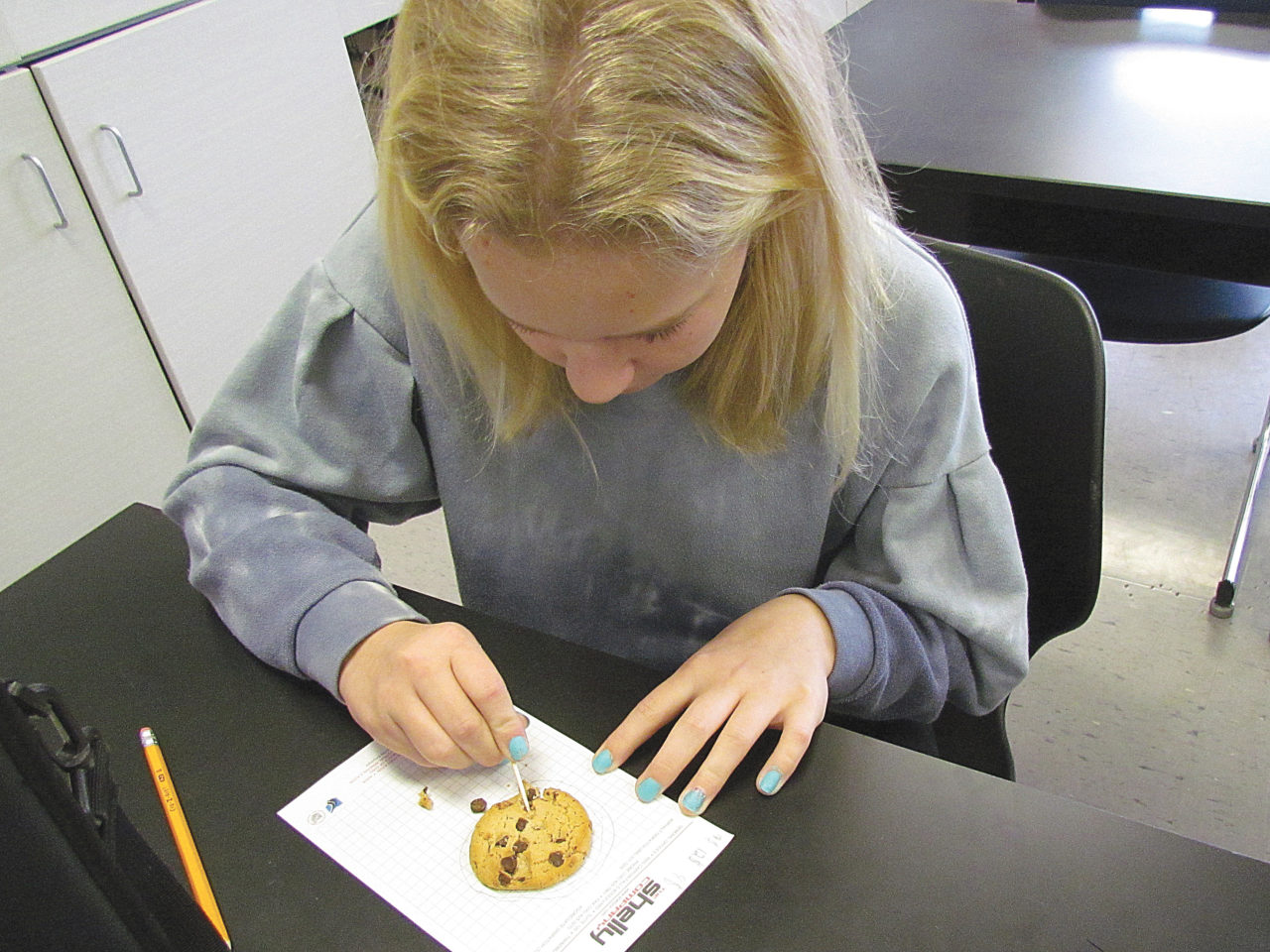Garrettsville – The Shelly Company is one of Ohio’s leading limestone, concrete and asphalt paving companies. With more than 90 locations and 1,600 employees around the state, you may wonder why they recently sent two of their brightest employees to spend the day with sixth-graders at James A. Garfield Elementary School in Garrettsville.
According to Natalie Walmsley, Material Coordinator at the Shelly Company, “This program is part of an initiative to increase outreach in areas around our mine sites,” she shared. “ We’d like to educate kids on some of the possibilities and future career options open to them, whether they plant to work right out of high school or attend trade school or college.” She and Jack Powers, Assistant Aggregate Operations Manager, spent the day with Heidi Drumheller,’s sixth grade science classes, who have been studying soil and erosion this term.
That day, Miss Natalie and Mr. Jack (pictured above with student Ben) also covered types of rocks, uses of rocks, and career options in their field and safety considerations. To begin, they discussed the similarities between a quarry and a pit. Students learned that both are types of mines, they learned that a quarry contains limestone, while a pit contains sand and gravel. Walmsley and Powers brought rock samples to show the class as they inquired what the kids like to do with rocks. One noted that she enjoyed painting on them, while another noted that his brother built a robot out of rocks. Another shared that his driveway was paved with limestone.
Powers explained how aggregates are blasted from quarries or dredged or dug from open pit mines. Workers use blasting explosives to free materials. They operate large equipment like rock drills, excavators, loaders, crushers, screens and conveyer belts to process stones, gravel and sand, and to process asphalt and concrete products. The duo showed a video entitled, ‘How Rocks Build the World’ where students learned of the vast variety of uses for rocks — from finely ground rocks used in deodorants, sunscreen and toothpaste to the ones used to construct roads, sidewalks, and buildings. The video noted that each person uses an estimated 22,000 pounds of aggregates each year.
They asked sixth grader, Ben, to help them illustrate how their employees get ready for a day of work at the quarry. Ben swapped his sneakers for some steel-toed boots, put on a bright orange and yellow vest, some safety glasses and a bright white hardhat — the Personal Protective Equipment (PPE) that is required for the job.
Later, Powers explained that all the useful material is removed from the mine, the site must go through a reclamation process. “It’s our obligation to the environment after we’re done mining,” he told the class. The process includes grading the walls to make them safe for wildlife and people to walk on. Once reclaimed, sites are fused or recreational areas, parks, or for wildlife habitat, like the company’s 224-acre Wildlife Habitat Site in Shalersville.
Since the students had been studying the rock cycle, they were quick to name the three types of rocks when quizzed by their guest presenters. They knew that igneous rocks like granite and basalt were made by the earth’s fire and heat. Sedimentary rocks, like sandstone, limestone, and shale resulted from weathering, and metamorphic rocks like slate and marble are the result of added pressure and heat.
Walmsley and Powers shared the variety of career paths places like the Shelly Company offer. They noted that those with an interest in geology, business, or mine engineering could come to the company after earning a four-year degree, but that entry-level positions are also available for those right out of high school or through trade school. Powers noted that he began at Shelly in high school, and has held a variety of capacities, including piloting a drone to help measure the amount of materials.

At the end of the program, students had the opportunity to give mining a try in a fun-for-all-ages exercise called cookie mining. Each student was credited $19 to invest in his or her mine. Each student was provided with a piece of graph paper. They could choose to purchase either a large chocolate chip cookie for $7 or a small, soft-baked one for $5. They were instructed to trace their cookie in the center of the paper. For equipment, they had the choice of a toothpick ($4) or a paperclip ($6). It cost $1 per minute to mine the chocolate chips from their cookie, using only the chosen tool, for a maximum of five minutes.
When the time was up, they counted their chips, and were credited back one dollar for each mined chip. Once they calculated the profit earned at their cookie mine, they needed to reclaim it by using their tool of choice to return the broken cookie bits back to the mine site. After discussing the pros and cons of cookie texture and tool choices, students tabulated their expenditures and calculated their profits. They discovered that new miners earned anywhere from $16 to $24 with their cookie mines; Chase was the student who earned the most, earning $32 from his cookie mine.
“A lot correlates with the sixth grade learning standards for rocks and minerals,” shared science teacher Heidi Drumheller. “It’s also beneficial for kids to see a variety of career choices, other than the standard options they typically see,” she shared. “It’s nice to have professionals come in and present other views and options for students to pursue after high school and/or college,” she added. “The kids were on their best behavior,” Drumheller beamed. “And Natalie and Jack did a great job engaging them with their presentation, videos, and hands-on activities.”
Walmsley noted that their program can be tailored to any age level and interest; they’ve presented to Boy Scouts working on a geology badge as well as students in Fairless Schools in Stark County. They are available to bring their presentation to other schools, and welcome the opportunity to host field trips, as well. “We want to engage with the communities where we work, “ she explained. Walmsley noted that the videos were produced through a partnership between the Smithsonian and the National Stone, Sand and Gravel Association (NSSGA).
For more information on presentations or field trips to the Shelly Company, contact Walmsley (Natalie.walmsley@shellyco.com or Powers at jack.powers@shellyco.com or call 877-279-8618.

















